Centauri Dreams
Imagining and Planning Interstellar Exploration
The Milky Way as an Outlier
How ‘normal’ is the Milky Way? It’s an interesting question because as we look out into a visible universe filled with perhaps 100 billion galaxies, we base many of our models for their behavior on what we know of our own. That this may not be the best way to proceed is brought home by a much smaller study, the comparison between our Solar System and what we’ve been finding around other stars. Finding Solar System analogs has proven surprisingly difficult, although older models assumed outer gas giants and inner rocky worlds as a common pattern.
Thus I am keeping an eye on a survey called Satellites Around Galactic Analogs (SAGA), which is looking into galaxies with smaller satellite galaxies. We’re only in the early days of this survey, with eight galaxies now examined in a new paper from lead author Marla Geha (Yale University). But the goal is 100 galaxies, with 25 of these studied within the next two years.
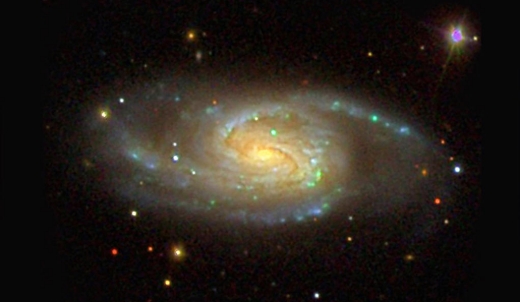
Image: A three-color optical image of a Milky Way sibling. Credit: Sloan Digital Sky Survey.
Even now, however, the results are intriguing. It turns out that the satellite galaxies of the Milky Way are far more sedate than those in other galactic systems comparable in luminosity and environment. It’s not uncommon for ‘sibling’ galaxy satellites to be producing new stars, but the Milky Way’s satellites are generally inert. Like our Solar System, our galaxy too may have its quirks.
“We use the Milky Way and its surroundings to study absolutely everything,” said Geha, “Hundreds of studies come out every year about dark matter, cosmology, star formation, and galaxy formation, using the Milky Way as a guide. But it’s possible that the Milky Way is an outlier.”
Like the study of exoplanet atmospheres we looked at yesterday, comparative surveys like these are essential for placing what we see around us in a much broader, if not universal context. Thus far SAGA has generated complete spectroscopic coverage within 300 kpc, counting eight Milky Way analogs. The process of choosing ‘analogs’ is detailed and painstakingly recounted in the paper, but the gist of it is that the team looks at a galaxy’s K-band infrared luminosity as a proxy for stellar mass and considers a host of factors related to the galaxy’s halo and its large-scale environment including other nearby galaxies.
Thus far, SAGA has uncovered 25 new satellite galaxies, 14 of which meet the survey’s formal criteria, plus an additional 11 that remain incompletely surveyed. Given that the Sloan Digital Sky Survey had already found 13 satellites among these galaxies, we thus far have 27 satellites around 8 Milky Way analog galaxies that have been subjected to exhaustive analysis.
As to the Milky Way itself, we continue to find what the paper considers ‘faint satellites’ as large-area imaging surveys continue, but the number of bright satellites has remained fixed since the discovery of the Sagittarius dwarf spheroidal galaxy about twenty years ago. Geha and team consider the catalog of bright Milky Way satellites to be largely complete.
The SAGA survey is in its early days, but it is striking that 26 out of the 27 satellite galaxies considered are actively forming stars, unlike both the Milky Way and M31. As the paper notes:
The above results suggest that the satellite population of the Milky Way may not be representative of satellite populations in the larger Universe. Expanding the number of Milky Way analog galaxies with known satellites is required to use these objects as meaningful probes of both cosmology and galaxy formation.
And this is also interesting:
We have characterized complete satellite luminosity functions for 8 Milky Way analog hosts. We find a wide distribution in the number of satellites, from 1 to 9, in the luminosity range for which there are five satellites around the Milky Way. We see no statistically significant correlations between satellite number and host properties, although any correlation would be hard to detect robustly with our small sample size of hosts.
Bear in mind as the SAGA Survey continues that until now, we have based most of our information about satellite galaxies on what we see right here in the Milky Way and in M31. We’re now developing the larger picture that can help us place galaxy formation in context. Finding that even the galaxy we live in is not typical would fit the pattern of recent exoplanet discoveries in suggesting that galaxy as well as planet formation is a deeply stochastic process.
The paper is Geha et al., “The SAGA Survey: I. Satellite Galaxy Populations Around Eight Milky Way Analogs,” accepted at the Astrophysical Journal (preprint).

A Statistical Look at Exoplanet Atmospheres
Comparative exoplanetology? That’s the striking term that Angelos Tsiaras, lead author of a new paper on exoplanet atmospheres, uses to describe the field today. Kepler’s valuable statistical look at a crowded starfield has given us insights into the sheer range of outcomes around other stars, but we’re already moving into the next phase, studying planetary atmospheres. And as the Tsiaras paper shows, constructing the first atmospheric surveys.
Tsiaras (University College, London) assembled a team of European researchers that examined 30 exoplanets, constructing their spectral profiles and analyzing them to uncover the characteristic signatures of the gases present. The study found atmospheres around 16 ‘hot Jupiters,’ learning that water vapor was present in each of them. Says Tsiaras:
“More than 3,000 exoplanets have been discovered but, so far, we’ve studied their atmospheres largely on an individual, case-by-case basis. Here, we’ve developed tools to assess the significance of atmospheric detections in catalogues of exoplanets. This kind of consistent study is essential for understanding the global population and potential classifications of these foreign worlds.”
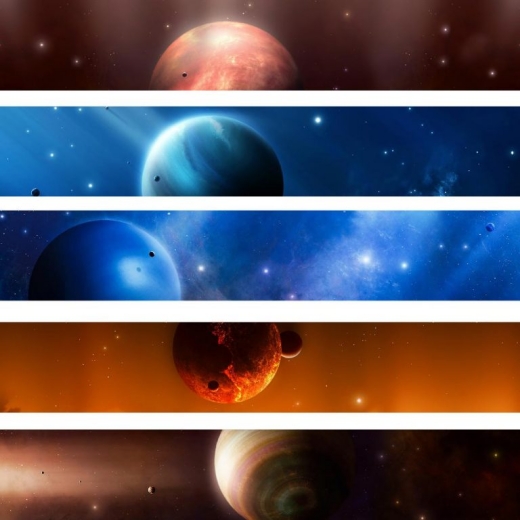
Image: An artist’s impression of the kind of systems studied by the UCL team. Credit: Alexaldo.
Presented at the European Planetary Science Congress (EPSC) 2017 in Riga, the study used archival data from the Hubble telescope’s Wide Field Camera 3 (WFC3), finding that most of the detected atmospheres show evidence for clouds, although the two hottest planets, with temperatures exceeding 1700 degrees Celsius, evidently have clear skies at least at high altitudes. Both of the latter show indications of water vapor, titanium oxide and vanadium oxide.
The authors have defined a metric they call the Atmospheric Detectability Index (ADI) to measure the statistical significance of an atmospheric detection, meaning that while we have 16 planets with atmospheres the metric finds significant, other less detectable atmospheres are present in the rest of the sample. The paper explains the 14 spectra without significant atmosphere detection as the result of opaque, high-altitude clouds or low water abundances. It is highly unlikely, in other words, that gas giant planets will fit any no-atmosphere models.
What jumps out of this work is the fact that the detectability of ‘hot Jupiter’ atmospheres through the ADI metric appears to be dependent on planetary radius rather than planetary mass.
“These results,” the paper adds, “indicate that planetary surface gravity is a secondary factor in identifying inflated atmospheres,” though we should also note that the paper identifies an outlying group of five planets with large radii and no detectable atmospheres. The other planets show the correlation between atmosphere and planetary radius. And it turns out that very hot planets produce strong results with this method. From the paper:
Very hot and highly irradiated planets, with atmospheric temperatures above 1800 K feature high ADI atmospheres. Our quantitative retrievals suggest that the cloud top-pressures in these planets are significantly high, meaning clouds are deep in the atmosphere, if present at all…, while retrieved water abundances are constant within the errors… We can conclude that planets with temperatures higher than 1800 K feature clear atmospheres, confirming that most of the element-carriers are present in a gaseous form at such hot temperatures.
We’ll see how the Atmospheric Detectability Index fares as it is applied to future, larger-scale surveys. For we’ll certainly need such surveys as we enter the era of extremely large telescopes on the ground and new missions that will produce huge numbers of new planet detections. The Tsiaras team’s work is important because it shows we are developing the tools and models that will be applied in the future to much larger samples of planetary atmospheres.
The paper is Tsiaras et al., “A population study of hot Jupiter atmospheres,” submitted to the Astrophysical Journal (preprint).

A Binary Main-Belt Comet
The paper in Nature covering an object known as 288P lays out the case in its title: “A Main Belt Comet.” But what makes this story stand out is the fact that 288P is also a binary.
A team of scientists led by Jessica Agarwal (Max Planck Institute for Solar System Research) discovered when 288P neared perihelion in September of 2016 that it was not one but two objects, asteroids of roughly the same mass and size, in a binary separated by about 100 kilometers. Moreover, they have verified that the small system is not quiescent.
Using the Hubble instrument, Agarwal and colleagues discovered that the increased solar heating due to perihelion was producing sublimation of water ice, in much the same way that the tail of a comet is created. Here’s how the paper describes the process on 288P:
Repeated activity near perihelion is a strong indicator of the sublimation of water ice due to increased solar heating. A model of the motion of the dust under the influence of solar gravity and radiation pressure suggests that the activity began with a brief release of comparatively large (millimetre-sized) grains in July, while from mid-September until at least the end of January 2017 (the last of our observations), the dominant grain size fell to ?10 µm… This indicates that the developing gas production first lifted a layer of large, loosely connected grains, possibly deposited around the end of the previous period of activity in 2011/12. After their removal and with decreasing heliocentric distance, the gas drag became sufficiently strong to lift also smaller particles.
As a main-belt comet, 288P may give us further insights into how water came to Earth. It is also the first known binary asteroid that can be classified as a main-belt comet.
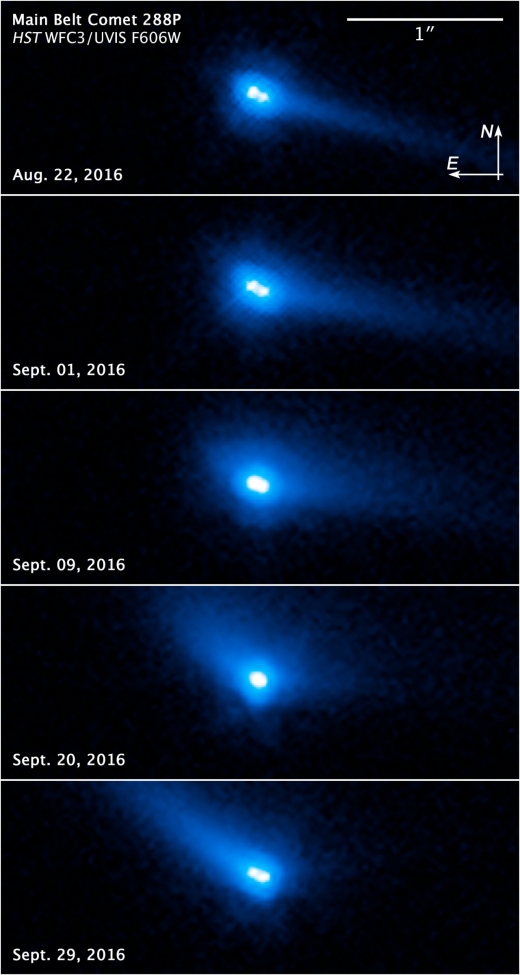
Image: This set of images from the ESA/NASA Hubble Space Telescope reveals two asteroids with comet-like features orbiting each other. These include a bright halo of material, called a coma, and a long tail of dust. The asteroid pair, called 288P, was observed in September 2016 just before the asteroid made its closest approach to the Sun. These images reveal ongoing activity in the binary system. The apparent movement of the tail is a projection effect due to the relative alignment between the Sun, Earth, and 288P changing between observations. The tail orientation is also affected by a change in the particle size. Initially, the tail was pointing towards the direction where comparatively large dust particles (about 1 millimeter in size) were emitted in late July. However, from 20 September 2016 onwards, the tail began to point in the opposite direction from the Sun where small particles (about 10 microns in size) are blown away from the nucleus by radiation pressure. Credit: NASA, ESA, and J. Agarwal (Max Planck Institute for Solar System Research).
288P’s activity gives us clues to its history. For surface ice cannot survive for billions of years in the main belt. As Agarwal notes, it would have to be protected by several meters of dust mantle, which makes 288P as a binary a relatively recent system, perhaps one that has existed for no more than 5000 years. We then factor in the growing interest in asteroids as delivery vehicles for water to the inner system to see why this system may become something of a benchmark.
Although an impact could have caused the breakup of the original asteroid, the researchers argue in the paper that breakup due to fast rotation is the most likely cause. Later torques caused by sublimation — the breakup would have exposed the ice for subsequent sublimation — could have caused the objects to move further apart:
A decisive factor for the subsequent development of the system is whether the sublimation will last longer than the time required to tidally synchronise the spin and binary orbital periods, which is 5000 years for equal-mass components but orders of magnitude longer for lower mass ratios. Sublimation-driven activity can last longer than 5000 years, such that for high-mass ratio systems it is conceivable that activity prevails after tidal synchronisation. In this case, the recoil force from the local sublimation of water ice can drive binary evolution.
288P is unusual in another way. Asteroid binaries are not uncommon, but most are discovered by radar (when close to Earth) or by analysis of the mutual eclipses revealed in their light curves, assuming a relatively small separation between the two components. Wide binaries like 288P rarely align to produce such eclipses and are too distant to be revealed by radar.
Indeed, it was the evident sublimation of water ice that drew the attention of the researchers. Although a larger sample of wide binaries is needed, Agarwal and team believe the sublimation activity played a decisive role in the evolution of this young binary, affected by the fact that the two components were of nearly equal size, distinguishing 288P from other asteroid pairs.
The paper is Agarwal et al., “A binary main-belt comet,” Naure 549 (21 September 2017), 357–359 (abstract).

Vintage Voyager: Online Video Resources
With Voyager on my mind because of its recent anniversary, I had been exploring the Internet landscape for archival footage. But Ioannis Kokkinidis made my search unnecessary with the following essay, which links to abundant resources. The author of several Centauri Dreams posts including Agriculture on Other Worlds, Ioannis holds a Master of Science in Agricultural Engineering from the Department of Natural Resources Management and Agricultural Engineering of the Agricultural University of Athens. He went on to obtain a Mastère Spécialisé Systèmes d’informations localisées pour l’aménagement des territoires (SILAT) from AgroParisTech and AgroMontpellier and a PhD in Geospatial and Environmental Analysis from Virginia Tech. Now a resident of Fresno CA, Ioannis tells us in addition how a lifelong interest in space exploration was fed by the Voyager mission and its continuing data return.
by Ioannis Kokkinidis
Introduction

Back in the end of August 1989, when I was 9 ½ years old and the whole family was on vacation, the Greek press set aside momentarily its coverage of the continuing shenanigans of Greek politics and the rapidly changing situation to the north of our borders due to the collapse of communism and instead put Voyager 2’s encounter with Neptune in its front pages. My late grandfather was an avid reader of newspapers, which I would also read afterwards. I devoured what I could get my hands on, which alas was not much, it was after all August.
The next year my family moved to California for two years, my father was a visiting professor at UCSF, and I read all the books and magazines about space I could find in the public libraries. I even discovered NASA’s Spacelink, a NASA public education computer service hosted by the Marshall Space Flight Center in Alabama, containing mostly NASA press releases, and I would dial in with our PC XT’s 2400 bps modem. However feeding my space interest was a privilege and my parents made me do a thing I truly dreaded in exchange for dialing the long distance number and indulging myself: play the piano.
After we returned to Greece keeping myself appraised of the latest space developments proved difficult since there is very little popular scientific press in Greece and the mainstream press is not that interested in space. When I got our first internet connection NASA’s Spacelink, now a website, was still up, it still had similar content, though more importantly the releases now included in the bottom instructions on how to get on NASA’s press listserv. I promptly signed up, and I still am on that listerv, becoming informed of the latest space developments, especially in an era before the current proliferation of internet space media made it possible to get the latest space news whenever you wish.
Space in general and NASA in particular have been trailblazers in the formation of the current internet media landscape. Early internet users were for the most part technically savvy people with a strong interest in space. When Mars Pathfinder landed in 1997 it became the first major mass internet event with some 200 million hits on its website, at a time when the internet is believed to have had fewer than 500 million internet users worldwide. Space enthusiasts have always had interest that the mainstream media would not quite satisfy and NASA has indulged those interested, posting pictures, press releases and blogs online, up to the point that today the press conferences are open to all and NASA takes questions from the public in social media.
The ability to consume the latest information about space today runs the whole specter, from basic articles intended for children to conference and peer review papers for professionals, which amateurs can also try to parse for meaning. This was not the case though during the planetary phase of the Voyager program. Per the Voyager books and documentaries I have seen over the years the Jet Propulsion Laboratory held a series of daily press conferences during encounter times that apparently were taped, footage of them is shown in said documentaries. Being on the 40th anniversary of the launch of the most successful planetary missions, I wondered if any of that content was available online. I have discovered that quite a bit was, especially of the 1989 Neptune encounter. When I asked online I was also told, and I did discover, that JPL also produced on a daily basis, and at times more often, 10-15 minute Voyager update videos intended for a general public that were apparently broadcast on PBS, in addition to being shown at Planetariums and science centers. I was able to also find several of these videos are available online too. To my surprise very little of this content is uploaded from official NASA accounts, rather it has been uploaded and collected by enthusiasts.
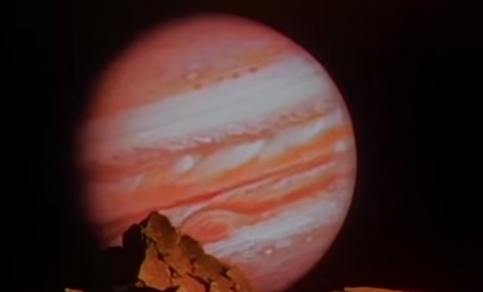
Image: Some documentaries mixed actual footage with artist’s renderings of the landscapes Voyager saw. This image is from a 1982 NASA presentation.
Understanding the origin of the content
NASA does have quite a bit of Voyager data and information up on its website. It still has the original press kits up, which I actually read them back when I dialed up at Spacelink. The scientific information collected is available for all at the Planetary Data System. Voyager has a website up, with a lot of retrospective information. There are several Von Karman lectures up on YouTube, as are press conferences organized both by NASA but also scientific societies such as the AGU. However these mostly date from the last 15 or so years, especially after YouTube was created. The older stuff has been put up by other people. Having watched the stuff and lived a few years both as a child and as an adult I have a few hunches on who is responsible for doing this public service. One needs first to understand how the education system works in the US.
In Greece primary and secondary education is highly centralized. The Ministry of Education in Athens decides what is to be taught in each grade, each class syllabus and even sends the school books and teachers to the public schools. In private schools the owners select their teachers, but the curriculum and books is the same as in public schools. For that matter the graduating exams at the end of the year there are given by public schools teachers to ensure that private schools are not places where bad students go to buy an education certificate. Students and parents have no control over what gets taught up to high school where some choice is introduced, except of course by their vote in the parliamentary elections, or even who teaches it, except by pressuring their local Members of Parliament. Physics teachers – who in Greece are all physicists graduates of four year universities – have no reason to entice students to take their class, the students are obligated to do so. Greeks schools are also seriously lacking in means, before an EU program about a decade ago only about 150 schools out of the 20,000+ that then existed in Greece had a school library, and though with EU funding and school mergers due to the financial crisis some 10-20% of schools now have a library, that is still a small fraction.
The American educational system is far more decentralized but also has more means. The federal Department of Education can set some guidelines and offer grants, but the educational standards are set at the state level. Major decisions such as hiring and school book choices are made at the school district level, with the school district being made up of representatives directly elected locally, rather than ministry of education centrally appointed functionaries. Now down at the school level students have quite a bit of class choice. As a result science teachers need to make their classes appealing to students in order to have them select it. One way to do so is to teach about cool things in class, and space is generally considered very cool. As a result teachers and schools have maintained such cool content like NASA produced educational material. Also American schools have many means not available to Greek schools, such as school libraries that can include a media section with such material. On top of that some 10% or so of American students are home schooled by their parents, and they often use such material to teach science class. Materials on the internet get copied around incessantly so it hard to track who is the original uploader, but after watching quite a bit of the material shown below I am under the impression that most of the videos have been originally taped by some science teacher or librarian, who eventually uploaded them online.
Jupiter encounters
Voyagers 1 and 2 encountered Jupiter back in 1979. Sony’s Betamax was released in 1974, VHS was released in 1977, there are testimonials on the internet of people watching the Voyager Jupiter updates as children every night on TV but if people recorded the updates at the time, they have not put them up, and neither has NASA. What I have been able to find is the following 24 minute video dating from 1982 that talks about the Voyager 1 and 2 encounters at both Jupiter and Saturn. The first 14 minutes are about Jupiter, the rest is about Saturn.
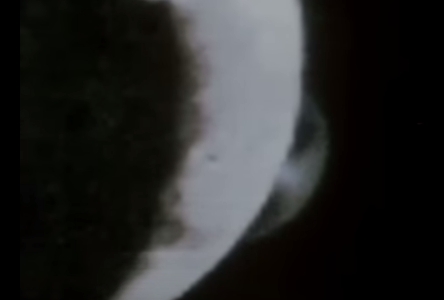
Image: Io’s volcanoes discussed in this 1982 broadcast.
https://www.youtube.com/watch?v=XAFXQ_EeyGs
Saturn encounters
Voyager 1 encountered Saturn in November 1980 and Voyager 2 in August 1981. We do not have online any of the daily press conferences or full Voyager updates; we do have though two educational documentaries from the time that include extended footage from them. In both cases they are of Voyager 2’s encounter with Saturn. Why Voyager 1’s encounter is not shown is unknown to me, but my guess is that these videos where shown in the run up to the 1986 Voyager 2 encounter with Uranus, and thus the idea was to show what Voyager 2 did in its last encounter. Both videos come from collectors of archival documentary footage on YouTube.
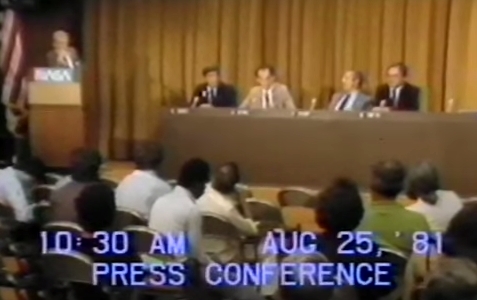
NASA Voyager 2 Spacecraft: Encounter with Saturn – 1981 Educational Documentary
https://www.youtube.com/watch?v=OGZk1SOIQaI
Voyager 2 Saturn Encounter as it Happened 1981 NASA Jet Propulsion Laboratory
https://www.youtube.com/watch?v=CJC4s5kijyU
Uranus Encounter
By 1986 video tapes had become more popular. While we do not have footage of any of the press conferences, we have footage of Voyager updates. This video begins in mid update, and then gives several other updates. It seems to have been recorded by somebody in Arizona, since interspaced among the Voyager Updates a small documentary about the USGS Astrogeology center in Flagstaff which is referred to as a local facility. Notice also the scroll for an upcoming Doctor Who episode.
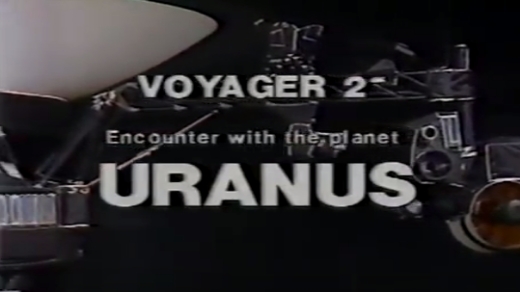
The Voyager Updates do not only deal with the Voyager program, they also give some more general NASA news. One of the updates give a retrospective on how 1977 when the Voyagers were launched Jimmy Carter was just sworn President and the Shah was still ruling Iran. Another updates talks about the upcoming 1986 launches of the Shuttle that will see Galileo, Ulysses and the Hubble Space Telescope get launched. Tragically, Challenger happened two days after Uranus closest approach.
https://www.youtube.com/watch?v=lnijUsIdxSc
Another interesting contemporary program from the time to watch is the Uranus episode of the long running BBC astronomy program The Sky At Night. The BBC has digitized its archive, though the link that YouTube gave me is not from a BBC account:
https://www.youtube.com/watch?v=hUriyE4sGd4
Neptune encounter
The Neptune encounter is far better documented than any of the previous five flybys. Its August timing, which meant that there was very little competing for attention, the experience over the excitement of the previous encounters and the ubiquity of video tapes means that there is quite a bit of material available. The first video is a preview press conference made three months before closest approach, with Ed Stone mostly recapping the previous flybys and explaining to the press new findings since published. In the end he also shows early Neptune pictures taken at the time:
https://www.youtube.com/watch?v=I4io958_BBo
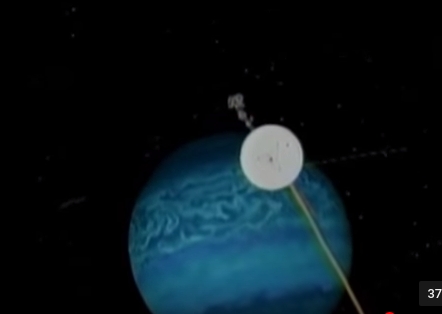 Image: Imagery shown by Ed Stone at the 1989 press conference on Voyager’s encounter with Neptune. Stone used these to explain what would happen in the upcoming encounter.
Image: Imagery shown by Ed Stone at the 1989 press conference on Voyager’s encounter with Neptune. Stone used these to explain what would happen in the upcoming encounter.
The following two videos, which appeared as YouTube suggestions after I had seen the rest of the material, purport to contain all the Voyager Updates of the Neptune encounter. They are over twelve hours, so I have only given them a cursory look:
https://www.youtube.com/watch?v=xkUmzPbqJVU
https://www.youtube.com/watch?v=CttozUMkEBA
CSPAN is the American equivalent of Parliament TV. Like Parliament TV it carries educational programs when Congress in not in session. Their oldest video tagged “Space” was a hearing on the Challenger disaster. They do not have Voyage briefings at Jupiter, Saturn or Uranus but they did show most of the Neptune press briefings. They also had an audience Q&A with the director of NASA’s planetary division, William Quaide on August 24, a few hours before Neptune closest approach. Interestingly most of the press conferences are not all the way to the end, CSPAN apparently cut coverage when they went over their allotted time.
August 21 1989 Voyager 2 Update
https://www.c-span.org/video/?8803-1/voyager-2-update
August 22 1989 Voyager 2 Update
https://www.c-span.org/video/?8812-1/voyager-2
August 23 1989 Voyager 2 Update
https://www.c-span.org/video/?8817-1/voyager-2-update
August 24 1989 Voyager 2 Update
https://www.c-span.org/video/?8855-1/voyager-2-update
CSPAN August 24 viewer call in with NASA chief scientist William Quaide on Voyager 2 at Neptune
https://www.c-span.org/video/?8857-1/voyager-ii-neptune
August 25 1989 Voyager 2 Update
https://www.c-span.org/video/?8864-1/voyager-2-flyby-neptune
On the evening of August 24 to August 25 PBS showed a program called “Neptune all Night” where they showed the hourly Voyager updates live and filled the time in between by having a panel in Philadelphia made of the host, a sci fi writer and a NASA scientist. They also had several guests, such as legendary Hollywood sci fi movie producer and several space scientists such as Jill Tarter. On top of that they did take several questions that were dialed in from all over the US. We do not see any of the panelists or guests, between the updates we have the panelists talking while television is showing Voyager animations such as flyovers of satellites or even Space Shuttle astronauts doing things in space. Two people did tape the program beginning at different points. The first video is from a Florida station and it is of middling quality. It is over five hours:
https://www.youtube.com/watch?v=VBR5OUtndg8
The second video is from New York’s PBS 13 and contains far more ads to become a subscriber to PBS than the previous video, or the Arizona PBS Uranus video. The tape is of higher quality, but in begins at the equivalent of the 4h 34 minutes mark from the previous video.
https://www.youtube.com/watch?v=G84w-z6LkDo
The two hour tape ended before the program did, a little after the 3 am Voyager Update. However NASA solar system exploration has put up the last three Voyager Updates of the morning of August 25, for 5 am, 6 am and 7 am in a YouTube video entitled “Voyager 2 at Neptune with Suzy Dodd”. Suzanne Dodd is the current Voyager project manager and she does host the 5 am and 6 am update, though not the 7 am update. At 8 am there was no update, instead Vice President Dan Quayle gave a speech that CSPAN has at its archives in two parts. The Suzy Dodd video is in much better image quality that the rest of the Voyager videos, either at YouTube or CSPAN. Very likely NASA still has the original videos in its archives and at much higher quality than what I found online.
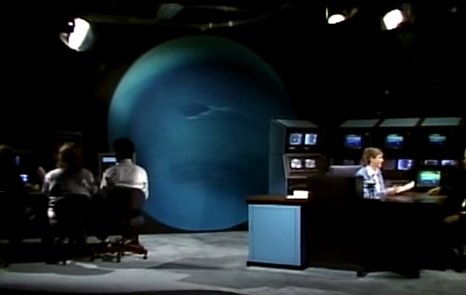
https://www.youtube.com/watch?v=AR_R5mFk9Tc
The Neptune encounter was big enough news that several mainstream media organizations made special reports about it. These YouTube videos do not come from the official station accounts. The first is a CNN special report on the Neptune encounter.
https://www.youtube.com/watch?v=Y11CVuxfvPE
The second special was made by TBS and contains reporting from Japan, which did participate in the Neptune and Triton Voyager occultation. It is hosted by Sidney Poitier and is available in 8 parts. The 8th part contains Chuck Berry playing live three songs at the Planetary Society’s farewell party.
Part 1 of 8
https://www.youtube.com/watch?v=y038-R3kwfw
Part 2 of 8
https://www.youtube.com/watch?v=gKVnzfiw1ac
Part 3 of 8
https://www.youtube.com/watch?v=c8eqYVFgzIU&t=5s
Part 4 of 8
https://www.youtube.com/watch?v=KPVwM7ikI4E
Part 5 of 8
https://www.youtube.com/watch?v=k7e1NDj-v0o
Part 6 of 8
https://www.youtube.com/watch?v=oKfVo_r4q7M
Part 7 of 8
https://www.youtube.com/watch?v=w8Uw1_Rad6Y
Part 8 of 8
https://www.youtube.com/watch?v=2adIOstO51g
Finally Sir Patrick Moore, who most likely was not knighted yet at the time, hosted a Neptune encounter episode for The Sky At Night. This program is far more complete and interesting, in my opinion, than the two other specials.
https://www.youtube.com/watch?v=H9UdqHL6b9Y
The Pale Blue Dot Press Conference
On June 6 1990 Ed Stone and Carl Sagan gave a press conference that for the most part summarized what the Voyagers had found during their planetary mission and revealed to the world the family portrait of the Solar System that Voyager 1 took. It was in this press conference that the famed Pale Blue Dot single pixel image of Earth was revealed. For the first 40 or so minutes Ed Stone gives a retrospective of Voyager, repeating for the most part what he had said a year earlier in the three months before Neptune press conference. He also though gives a few scientific updates on Neptune. After 40 minutes he shows the family portrait of the 6 planets, followed by Carl Sagan talking for 10 minutes on the portrait, followed by 30 minutes of Q&A.

https://www.youtube.com/watch?v=ZQCTgCF8Khk
The videos in retrospective
Over a quarter of a century since the Pale Blue Dot press conference the more interesting part about these videos is what they reveal about the time they were produced. In the Neptune press conferences the Voyager team fielded questions from West German reporters, the Wall after all fell in October 1989 and Germany was reunified in 1990. Carl Sagan proposes that we have a Joint US Soviet program to send people to Mars, the collapse of the Soviet Union was completely unexpected for everyone. Viewers tend to ask the same questions: Why is Voyager 2 not going to Pluto? Why did Voyager 1 not also visit Uranus and Neptune? Why did you choose Triton over Pluto? Did you find any evidence of alien life, preferably intelligent? When are we sending people to Mars? Did you find evidence of a wormhole, like in Star Trek The Motion Picture? Can you talk about the Golden Record?
The Voyager team does promote the next steps: We will use Hubble Space Telescope images, after its upcoming launch, to follow up on Uranus and Neptune. Galileo to Jupiter is about to launch, and we have proposed Cassini and CRAF as follow up, if Congress approves the missions. Magellan was launched 6 months ago, the long launch gap is over, and it was due to the Challenger disaster. With the power of hindsight we can follow up. Magellan has been called Voyager 3 because it followed its engineering. It was very successful but it is alas the most recent American mission to Venus. Galileo was also a successful mission but suffered from being unable to unfurl its High Gain Antenna. Cassini was approved, and its mission just ended. CRAF though, which intended to flyby an asteroid and orbit a comet on which it would throw a projectile was cancelled. Its science goals though were investigated by Stardust, Deep Impact and Rosetta.
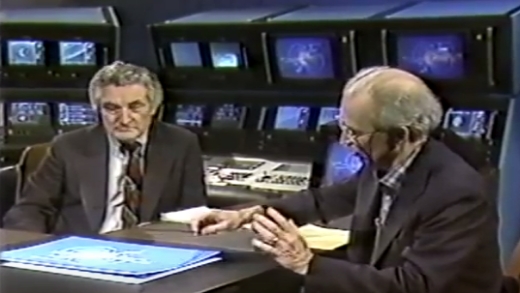
Voyager afterwards
The Voyager program did not end with the Solar System family portrait, for that matter it was not even the last images taken by the imaging subsystem. At the time both Voyagers were used as astronomical observatories, targeting stellar sources in the Ultraviolet. A few months later though they rewrote the spacecraft’s operating system and turned off all the instruments except those measuring fields and particles. During the Shoemaker Levy 9 collision NASA considered reactivating the imaging system to take pictures of the event which was not visible from earth. By that time though the imaging team had dispersed and it was hard to reassemble it. In any case Galileo, en route to Jupiter, took better images. From the Jupiter video already it was repeatedly stated that their last target was the edge of the heliosphere. In the Jupiter video Ed Stones expects that to happen by the end of the century, in the Pale Blue Dot conference he expected that in the first decade of the 21st century.
Throughout the 1990s I would read on any updates on the Voyagers sent by the NASA listserv. Most often they were associated with launch anniversaries or lectures at the fall AGU meeting in San Francisco. Both spacecraft did keep on moving outwards into unexplored part of the heliosphere. Voyager 1 crossed the termination shock at 94 AU in December 2004 and Voyager 2 crossed it at 84 AU in August 2007, entering the heliosheath, where the solar wind is subsonic. Where it ended and the Galactic magnetic field started was a point of contention, especially since the plasma spectrometer on Voyager 1, though not Voyager 2, has failed. In 2012 Voyager 1 did see a dramatic increase in external galactic cosmic rays as opposed solar particles, but we were not certain if the spacecraft had crossed into interstellar space because the magnetic field had not changed direction. Eventually though tape playback of the plasma wave instrument data showed that indeed, in 2012, Voyager 1 had crossed the heliopause and was now in the Galactic magnetic field. Voyager 2 has yet to cross the heliopause though that is expected to happen relatively soon.
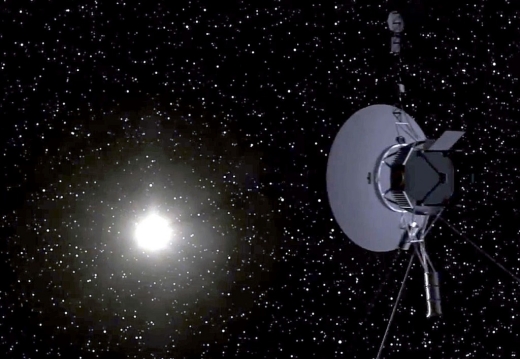
Image: Voyager moving beyond the Solar System. Credit: NASA.
The Golden Record
It seems that no Voyager article or documentary is complete with talking about the Golden Record and so will I. In all honesty I always found the pictures taken by the Voyagers more interesting than the record. The artifact is intended to be read by aliens who might run into the probes and contains instructions on how to use it. The instructions assume that the aliens are capable of interpreting the visual signs that we have put up sufficiently to decode the contents of the record. This is a very large assumption considering we have no idea what aliens can do and how. For one thing over a century after their discovery, Linear A tablets have never been deciphered. We believe that like Linear B tablets, which are written in Greek, they are accounting ledgers from the Minoan palaces where they were found, but until we read them we cannot be sure. On top of that the Voyager symbols are written in unique characters. The Phaistos Disc is written in a unique script, closest relative of which is the Arkalohori Axe. Wikipedia lists 26 decipherment claims for the Phaistos Disc which remain fanciful since we cannot apply them to another text to see if they make sense there. Michael Ventris’ decipherment of Linear B became accepted after it was used to read tablets that were published after he and John Chadwick published his discovery. Perhaps it would have been better if we had also printed instructions in English.
But say that alien do read the record, which contains both images and sounds coded differently. On top of that the human speech is in 55 languages. Much as Sagan and Druyan did try to give a snapshot of all human civilization, it is very hard to claim that it is an objective view of mankind. None of the contents, either images or songs, deal with war or any other ugly part of humanity. Trying to understand human civilization from the Golden record is like trying to understand Athens of the Classical Era from Pericles’ Funeral Oration: Both are wonderful documents but they portray their world as they wish it to be, rather than what it is. Still though they tell us quite a bit about ourselves and it was a great idea to include the Golden Record on the spacecraft. I sincerely hope that the project to write a repository of Earth Information on New Horizons does happen.

New Horizons After 2014 MU69
If New Horizons can make its flyby of Kuiper Belt Object MU69 at a scant 3500 kilometers, our imagery and other data should be much enhanced over the alternative 10,000 kilometer distance, one being kept in reserve in case pre-encounter observations indicate a substantial debris field or other problems close to the object. But both trajectories, according to principal investigator Alan Stern, have been moved closer following a ten-week study period, and both are closer than the 12,500 kilometers the spacecraft maintained in its flyby of Pluto.
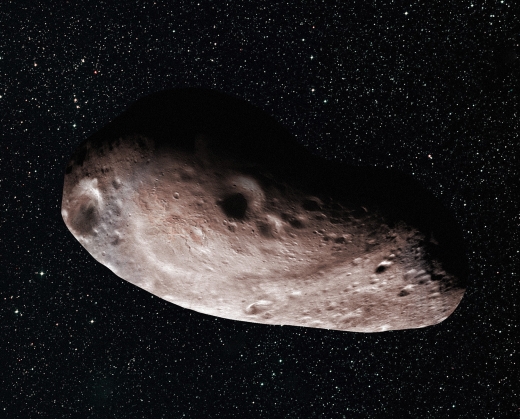
Image: Artist’s concept of Kuiper Belt object 2014 MU69, which is the next flyby target for NASA’s New Horizons mission. Scientists speculate that the Kuiper Belt object could be a single body (above) with a large chunk taken out of it, or two bodies that are close together or even touching. Credit: NASA/Johns Hopkins University Applied Physics Laboratory/Southwest Research Institute/Alex Parker.
Stern made the statement in early September at a meeting of the Outer Planets Assessment Group (OPAG), in which he also pointed out that flyby observations of the distant KBO will commence in August of next year in preparation for the early January arrival in 2019. The process of returning acquired data to Earth is estimated to take up to 20 months.
We also get this heartening news: Stern considers the Kuiper Extended Mission of New Horizons to be ‘multi-pronged,’ with the January 1 flyby of MU69 perhaps the prelude to further operations. New Horizons has sufficient fuel and power to operate until roughly 2035, and the downlink of MU69 data will end in September of 2020. The current extended mission was approved for the period 2016-2021. Will there be another?
According to Stern’s presentation at OPAG, the current extension involves not just the flyby of MU69, along with heliospheric plasma, dust, and neutral gas observations in the Kuiper Belt, but also distant observations of up to 30 other KBOs and numerous Centaurs. These studies involve searches for satellites, rings and dust along with examination of KBO light curves and shapes, with numerous papers on these results said to be in early stages of preparation.
With enough power and fuel to make it well into the 2030s, New Horizons, which is after all the only spacecraft with the opportunity to make these observations, could continue its active work for many years. An extended mission from 2021 to 2024 would allow additional KBO flyby search time for future targets as well as continuing Kuiper Belt observations.
And on the question of what happens after New Horizons, Stern’s presentation at OPAG included the possibility of a Pluto orbiter, which is already being studied at SwRI, Ball Aerospace, Lockheed-Martin and NASA GSFC. A tantalizing thought, that.
Jeff Foust quotes Stern in The Space Review as saying this:
“I think New Horizons has a bright future, continuing to do planetary science and other applications. There’s fuel and power onboard the spacecraft to operate it for another 20 years. That’s not going to be a concern even for a third or fourth extended mission.”
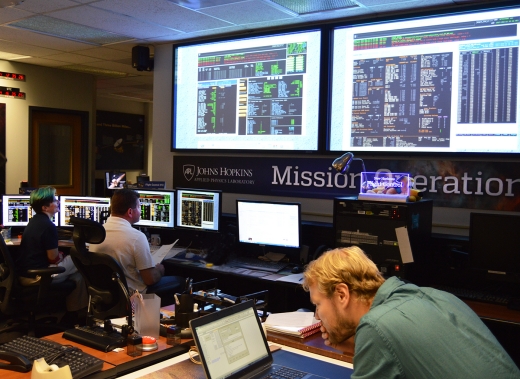
Image: Flight controllers (from left) Katie Bechtold, Ed Colwell and Jon Van Eck, working in the mission operations center at the Johns Hopkins Applied Physics Laboratory in Laurel, Maryland, confirm data indicating that the New Horizons spacecraft had safely exited hibernation on Sept. 11, 2017. Credit: NASA/Johns Hopkins University Applied Physics Laboratory/Southwest Research Institute.
Meanwhile, New Horizons ‘awakened’ from a five-month hibernation period on September 11, being brought over the next three days into active mode, in which science instrument checkouts and data collection activities can resume, to be continued until mid-December. From the latest JHU/APL news update outlining the course of the coming months:
The spacecraft will train its instruments on numerous distant KBOs, making long-distance observations with the telescopic Long Range Reconnaissance Imager (LORRI), while also continuously measuring the Kuiper Belt’s radiation, dust, and gas environment. The team also will test the spacecraft’s instruments in preparation for next year’s approach to MU69, and transmit a new suite of fault-protection software – also known as autonomy software – to New Horizons’ computer in early October.
On December 22, New Horizons again goes into hibernation, to be awakened on June 4, 2018, at which point preparations for the MU69 approach will go into high gear. The spacecraft is currently 3.89 astronomical units (AU) from MU69 as Kuiper Belt exploration continues.

A Fleet of Sail-driven Asteroid Probes
One of the great values of the Kepler mission has been its ability to produce a statistical sample that we can use to analyze the distribution of planets. The population of asteroids in our own Solar System doubtless deserves the same treatment, given its importance in future asteroid mining as well as planetary protection. But when it comes to main belt asteroids, we’re able to look up close, even though the number of actual missions thus far has been small.
Thus it’s heartening to see Pekka Janhunen (Finnish Meteorological Institute), long a champion of intriguing ‘electric sail’ concepts, looking into how we might produce just such an asteroid sampling through a fleet of small spacecraft.
“Asteroids are very diverse and, to date, we’ve only seen a small number at close range. To understand them better, we need to study a large number in situ. The only way to do this affordably is by using small spacecraft,” says Janhunen.
The concept weds electric sails riding the solar wind with a fleet of 50 small spacecraft, the intent being that each should visit six or seven asteroids, collecting spectroscopic data on their composition and taking images. Dr. Janhunen presented the idea at the European Planetary Science Congress (EPSC) 2017 in Riga on Tuesday September 19.
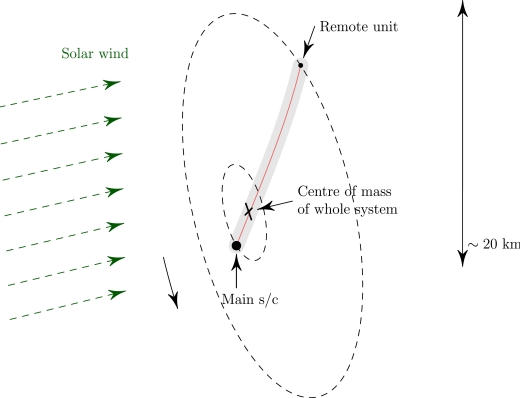
Image: The single-tether E-sail spacecraft. Credit: Janhunen et al.
Electric sails ride the solar wind, that stream of charged particles that flows constantly out of the Sun. While solar sails take advantage of the momentum imparted by photons on the sail, and beamed energy sails are driven by microwave or laser emissions, electric sails use the solar wind’s charged particles to generate all the propulsion they need without propellant. What Janhunen envisions is a tether attached to one end of a spacecraft, to which is attached an electron emitter and a high-voltage source, all connected to a remote unit at the other end.
The tether makes a complete rotation every 50 minutes, creating a shallow cone around a center of mass close to the primary spacecraft. Each small craft can change its orientation to the solar wind, and thereby alter its thrust and direction. Janhunen’s presentation at the EPSC made the case that a 5 kg spacecraft with a 20 kilometer tether could accelerate at 1 millimeter per second squared at the Earth’s distance from the Sun. Coupled with the boost provided by the launch itself, this is enough to complete a tour through the asteroid belt and return within 3.2 years.
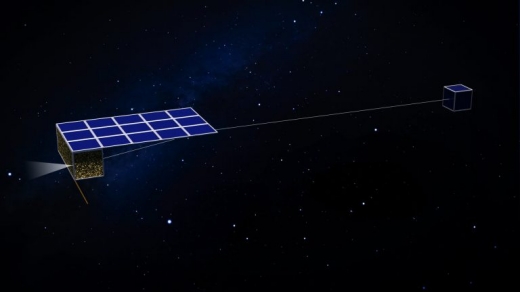
Image: Artist’s concept of the spacecraft. Credit: FMI.
These spacecraft are small enough (Janhunen refers to them as ‘nanosats’) that they cannot carry a large antenna. Instead, the mission concept calls for each spacecraft to make a final flyby of the Earth to download mission data. The financial numbers are compelling. Billions of Euros would be involved in attempting a flyby of 300 asteroids with conventional methods, while Janhunen’s fleet of nanosats could, he believes, fly this mission for 60 million Euros.
The payoff could be substantial:
“The nanosats could gather a great deal of information about the asteroids they encounter during their tour, including the overall size and shape, whether there are craters on the surface or dust, whether there are any moons, and whether the asteroids are primitive bodies or a rubble pile. They would also gather data on the chemical composition of surface features, such as whether the spectral signature of water is present.”
Working with ever smaller payloads is a recurring theme in deep space exploration, the ultimate example being Breakthrough Starshot’s study of a laser-beamed sail mission to Proxima Centauri’s planet, one that would deploy a fleet of sails just meters to the side, each carrying a payload as small as a microchip. In Janhunen’s concept, the spacecraft are capable of carrying a 4-centimeter telescope capable of resolving asteroid surface features, along with an infrared spectrometer that can analyze reflected light to determine the object’s mineralogy.
With flybys at a range of about 1000 kilometers, the spacecraft would be able to image features to a resolution of 100 meters or better, and with multiple targets for each, the catalog of main belt asteroids that we have seen up close would suddenly mushroom. The mission, being referred to as the Asteroid Touring Nanosat Fleet, would help us catalog the various types of asteroids and provide valuable analysis of their composition and structure, all of which would add to our expertise if and when we ever have to nudge an asteroid into a new trajectory.
200,000 Euros per asteroid is a strikingly efficient use of resources, and the engineering involved in deploying Janhunen’s fleet of electric sails would give us priceless experience as we work with other mission concepts that involve the solar wind. But can we ride a wind as mutable and unpredictable as this one while ensuring the kind of pinpoint navigation we need? Questions like these will need answering in space through the necessary precursors.


